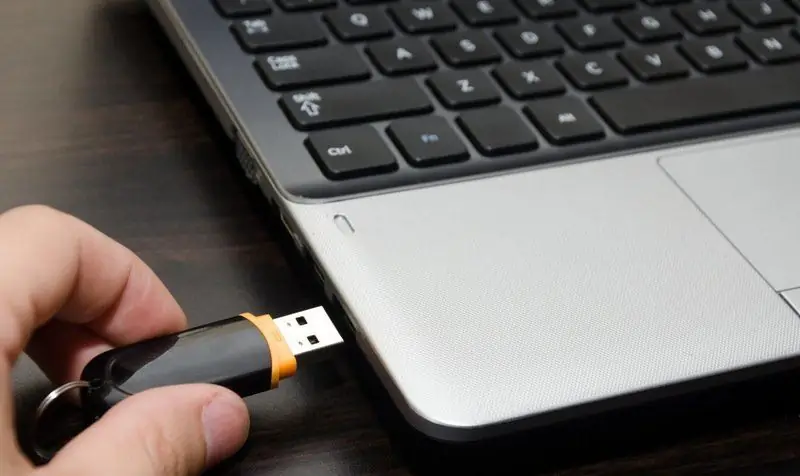
Table of contents:
- Why the computer does not see the USB flash drive and solutions to the problem
- The flash drive is not formatted
- Drive letter autoset failure
- Drivers are out of date or not working
- Disabled ports on the front panel of the system unit
- Virus attack
- Problems with extension cords, splitters
- Disabled ports in BIOS
- File system crashes
- USB port problems
- Media malfunction
- Author Bailey Albertson [email protected].
- Public 2023-12-17 12:53.
- Last modified 2025-01-23 12:41.
Why the computer does not see the USB flash drive and solutions to the problem
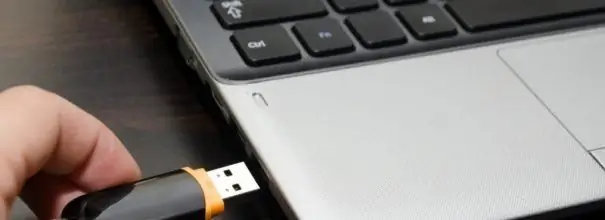
There are quite a few options for saving an "invisible" flash drive, and the main ones are discussed in the article. But before proceeding to reanimate the problem drive, try to copy data from it using special recovery utilities such as Recuva or EasyRecovery.
Content
-
1 Flash drive is not formatted
1.1 What to do
-
2 Failed to autoset drive letter
2.1 How to fix
-
3 Outdated or not working drivers
3.1 Problem solving
-
4 Disabled ports on the front panel of the system unit
4.1 Troubleshooting
-
5 Virus attack
5.1 How to proceed
-
6 Problems with extension cords, splitters
6.1 Possible solutions to the problem
-
7 Disabled ports in BIOS
7.1 What to do
-
8 File system failure
8.1 Correction options
-
9 USB port problems
-
9.1 How to solve the problem
9.1.1 Video: USB socket repair
-
-
10 Media malfunction
10.1 Problem solving
The flash drive is not formatted
Unformatted media most often becomes "invisible" to Windows. This may be due to any operations performed with the flash drive (for example, you installed Linux boot files on a removable disk). Also, the computer will not see the new USB flash drive.
What to do
You can restore the visibility of the flash drive through "Disk Management". To do this, follow the instructions below:
-
Run Win + R. In the window that opens, enter diskmgmt.msc and click OK.

Run program Run is present in all versions of Windows
-
Find the removable device in Disk Management (the disk will be visible even if it is not in Explorer). Right-click on it and select "Format".

Disk management Formatting the flash drive may take a while
If the flash drive is missing from Disk Management, try reinstalling (updating) the drivers. How to do this is described below.
Drive letter autoset failure
When you connect any drive (disk, flash drive, memory card, etc.) to a computer, Windows assigns it a letter that is different from the letter of the already mounted media. For example, if your hard disk is partitioned into C and D partitions, the flash drive will be assigned the letter E. It happens that autoinstall fails for various reasons and tries to assign a non-unique drive letter to the drive. Result - there is no USB flash drive in the system.
How to fix
Solving the problem is easy, you just need to assign a unique drive letter manually. This is done like this:
-
Start Disk Management again. In Windows 10, this can be done by right-clicking on the Start menu icon and selecting the appropriate item.

Windows 10 menu Windows 10's secondary menu contains some very useful commands and utilities
-
Right-click on the removable media and select "Change drive letter or drive path".

Disk management window Disk Management Console is a powerful admin tool
-
In the new window, click "Change" and assign any letter to the flash drive.

Setting a drive letter By default, the system offers to assign the next letter in alphabetical order to the USB flash drive
-
Answer yes to the system warning.

System warning All information from the flash drive will be deleted completely
If you assign the letter Z, X or Y (located at the end of the alphabet) to a USB flash drive, the risk of similar problems in the future becomes significantly lower.
Drivers are out of date or not working
A common malfunction more common on older computers. Sometimes the installed drivers can conflict with each other, causing crashes at the software level.
Solution to the problem
The problem is solved in a trite way. We remove old and install new drivers like this:
-
Go to the "Control Panel". To do this, expand Utilities from the Start menu. Select the item you want.

Start Menu The "Control Panel" can be used to change a wide variety of settings
-
In the window that appears, find and run the "Device Manager".

Settings The Control Panel is part of the Microsoft Windows user interface
-
Select USB Controllers from the list and right-click on the USB Mass Storage Device row. Click Remove.

Storage devices USB storage devices are configured automatically at login
-
At the top of the window, click on the monitor icon. The system will automatically update the equipment with the installation of the necessary drivers.

Configuration update Equipment configuration update also occurs automatically
You can also try updating (reinstalling) drivers using special utilities, the most famous of which is DriverPack Solution.
Disabled ports on the front panel of the system unit
This happens after repair or maintenance of the system unit, occasionally after purchasing a new computer. The reason for this is the human factor; when assembling a PC, they simply forget to connect the front panel connectors.
Debugg
Determining the problem is fairly easy, plug the drive into one of the ports on the rear panel. If the flash drive works, you will have to disassemble the system unit:
-
Remove the system case cover. Find the F_USB1, F_USB2 connectors on the motherboard.

Motherboard There may be more ports, they will be designated F_USB "corresponding number"
-
Locate the front USB cable.

USB plug Mistakes when connecting will not work due to the special design of the connectors
-
Connect the plug to one of the connectors.

USB connection You can connect to any connector
If you are not confident in your own abilities and are afraid to break something, or your computer is under warranty, contact the service center.
Virus attack
In general, viruses are associated with many problems in Windows, both software and hardware. The "invisibility" of a flash drive is no exception.
How to proceed
The problem is solved by installing antivirus software and scanning all disks for malware. If after scanning the flash drive becomes visible, check it too. Let's consider the process using the example of scanning the system with the AVZ utility (but of course, you can use any other antivirus, including the Windows Defender built into Windows):
-
Download the scanner, unzip the archive and run AVZ.exe. In the program window go to the "File" tab and update the anti-virus databases.

Database update Updating antivirus signatures is required to detect current viruses
-
Check all disks and the "Perform disinfection" item. Click the Start button.

Start scanning Scanning takes place in the so-called "quiet mode" and absolutely does not interfere with computer work
-
If there really was a problem with viruses, after scanning and disinfecting the system, you will see the problematic USB flash drive in the list of drives. Check it and run the procedure again.

USB flash drive scan After scanning, it is advisable to format the USB flash drive
In fact, the topic of virus attacks is much more extensive. It is impossible to describe the problem within one article. More detailed information on it can be obtained on the Internet (preferably in specialized forums).
Problems with extension cords, splitters
If you use all sorts of extension cords and splitters (USB hubs) to connect external USB devices, there is a high probability that the PC does not see the USB flash drive because of them. Cheap AliExpress crafts are the most common problem.
Solutions to the problem
The check in this case is made by simply connecting the drive to the USB port directly. If the flash drive works, but you still need a USB hub, you can arrange additional power supply. Usually, even the cheapest devices have a connector for an external source. You will need a power supply with an output voltage of 5 volts and a plug suitable for the connector.
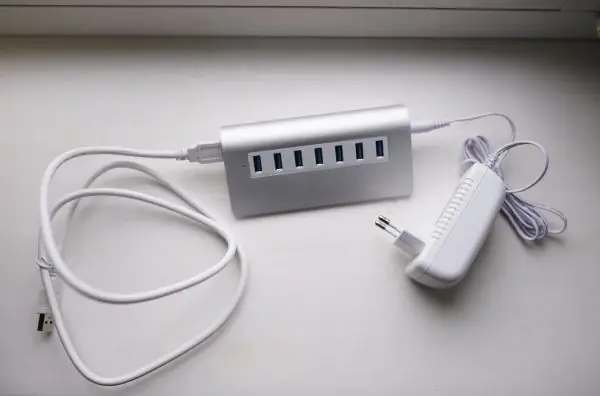
Some hubs are sold with a power supply included
A sales assistant in the store will help you choose the correct power supply. But if this recommendation did not help, you will have to purchase a better USB hub or look for the cause of the problem in something else.
Disabled ports in BIOS
Sometimes the system does not see the USB flash drive because USB is disabled in BIOS. This happens infrequently, since the ports are always activated by default.
What to do
You need to get into BIOS and enable USB ports. In the case of the UEFI BIOS, we do it as follows:
-
During computer startup or restarting, press Delete, F2 or F10 several times (different devices may have different BIOS entry buttons, including F1, F3, F12, Esc). Once in BIOS, go to the Advanced tab. Select USB Configuration.

Configuration window The BIOS of your computer may differ significantly from that shown in this example
-
Click on the USB Controller line.

Turning on the controller Detailed information on different types of BIOS can be found on the Internet
-
Activate the USB controller with the Enabled button.

Controller activation Some BIOS menus may be translated into Russian
-
Go to the Exit tab. Click Save Changes and Exit.

Saving settings Now wait for your computer to restart
-
If unsuccessful, you can try resetting the BIOS settings to default settings. On the Exit tab, select Load UEFI Default and click the Yes button.

Default settings All settings in BIOS will be reset to default
If you cannot get into the BIOS (for example, there is a lock) or do not find the necessary settings, study the instructions for your computer or contact the service center.
File system crashes
In this situation, when you connect the media, the system will inform you that the device is not formatted or has a RAW file system. The subsequent formatting of the flash drive cannot be completed (Windows gives an error message).
Fix options
Alternatively, use one of the special programs for low-level formatting. For example, the Formatter SiliconPower utility:
-
Download the utility. Unpack the archive and run the Formatter SiliconPower executable file. A warning will appear that all data from the flash drive will be erased. Click Format.

SiliconPower launch Formatter SiliconPower does not require installation
-
After a few seconds (a window with an exclamation mark appears), remove and reinsert the media.

Notification window Don't forget to click OK to continue
-
Formatting can take several minutes.

Formatting process Do not remove the USB flash drive from the port during formatting
-
When finished, click OK.

Completion of the operation Among other low-level formatting utilities, Formatter SiliconPower is perhaps the fastest and easiest
Also, the following programs are suitable for working with an "invisible" flash drive:
- MiniTool Partition Wizard,
- HDD Low Level Format Tool,
- HP USB Disk Storage Format Tool,
- SD Formatter,
- Format USB Or Flash Drive Software,
- EzRecover,
- JetFlash Recovery Tool.
USB port problems
It is not uncommon for the USB port itself to fail. Typically, a connector breaks due to careless handling or contamination. Sometimes the flash drive is visible, but periodically it "falls off" - it becomes inaccessible.
How to solve the problem
Connect the device to another jack or PC. If the flash drive works, take a close look at the problematic USB port. It happens that dust accumulates in it, contacts are oxidized. If there is dirt, disconnect the PC completely and clean the connector using an old toothbrush, dipping it in alcohol. Wait until the liquid has completely evaporated before turning on the device.
Contact a professional to replace the USB ports in your computer.
Video: USB socket repair
Media malfunction
Physically, the flash drive can be damaged by impact (for example, as a result of falling), getting wet, exposure to too low or too high temperatures. The failure of the device is characterized by the absence of light indication (most flash drives have a built-in LED). Also, there is no system sound when connected to a PC. Accordingly, the flash drive is absent in the "Explorer" and "Devices". In addition, other computers cannot see the drive.
Solution to the problem
Buying a new drive or (especially if valuable information was stored on the flash drive) contacting a service center, where, perhaps, a specialist can repair the device or, at worst, "pull out" the contents from it.
A flash drive today, without exaggeration, is the most popular storage medium with a lot of advantages: mobility, versatility, a decent amount of memory, high read / write speed. But it so happens that the computer does not want to see her. There are many reasons for the invisibility of the carrier (as well as the options for solving the problem). The article discusses typical situations that users encounter most often and the main ways to restore the performance of a flash drive.
Recommended:
What To Do If, After Flashing Android, The Phone Or Tablet Does Not Turn On, Does Not See The Network, Does Not Charge

Why does my smartphone or tablet not work after changing the Android version. How to troubleshoot various problems. How to properly reflash a device
A Laptop Or Computer Does Not See A WiFi Network: What To Do, How To Solve The Problem With Wi-Fi Connection

Why does the system not display your Wi-Fi access point? What to do if only your network is not visible or if the list of connections is completely empty
Why On Windows 10 The Start Button Does Not Work And The Main Menu Does Not Open
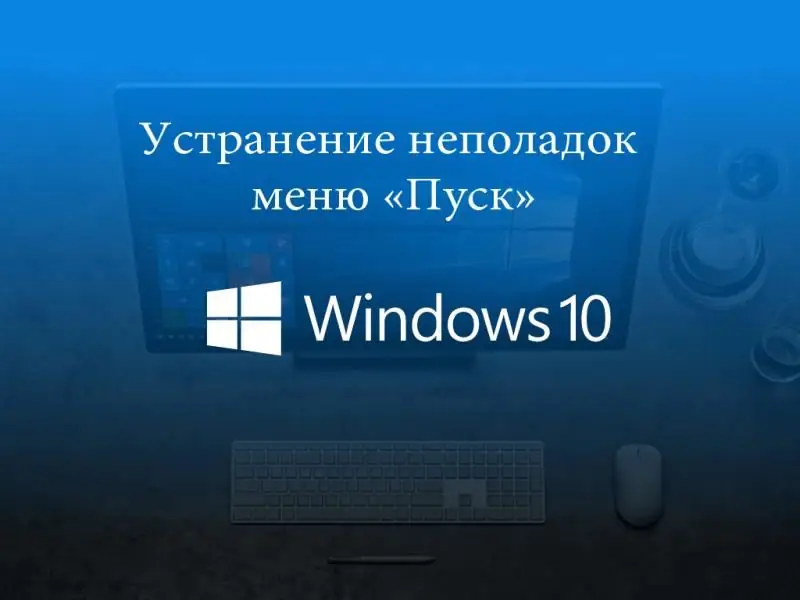
The most common problems in the "Start" menu on Windows 10. The reasons for the appearance. Solutions: universal and for specific cases
What To Do If Yandex Browser Does Not Open On A Computer - Why The Program Does Not Start, How To Make It Work

Why "Yandex Browser" does not open in Windows. Solution to the problem: disabling autorun, updating and reinstalling the browser, clearing the cache and registry
What To Do If Pictures Are Not Displayed In The Browser - Why This Happens And How To Solve The Problem, Step-by-step Instructions With Photos
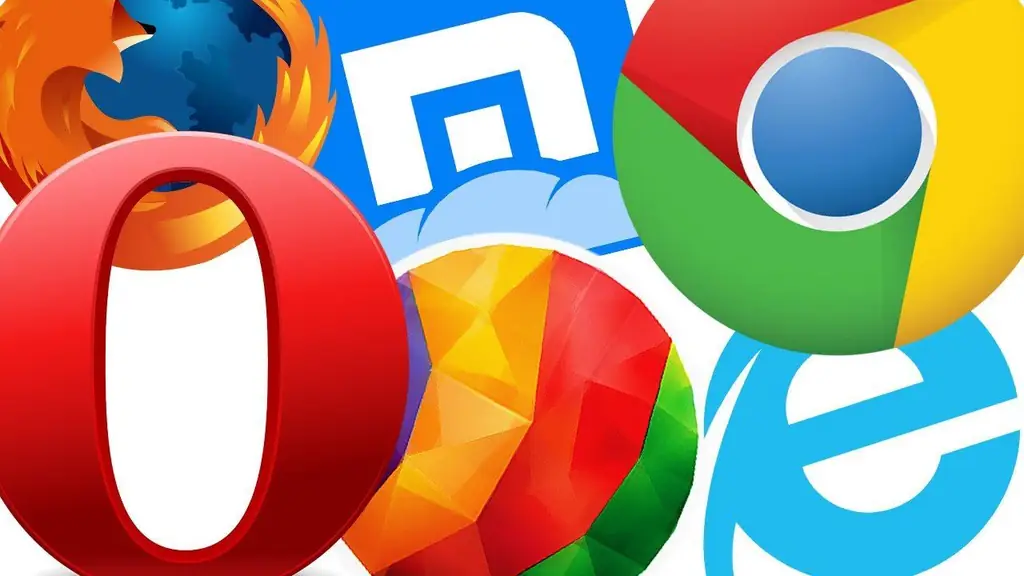
In what cases images are not displayed in the browser. Possible causes of the problem. How to resume displaying images and prevent browser disruption
